Chapter: 11th Physics : UNIT 6 : Gravitation
Universal Law of Gravitation
Universal
Law of Gravitation
Even
though KeplerŌĆÖs laws were able to explain the planetary motion, they failed to
explain the forces responsible for it. It was Isaac Newton who analyzed KeplerŌĆÖs
laws, GalileoŌĆÖs observations and deduced the law of gravitation.
NewtonŌĆÖs
law of gravitation states that a particle of mass M1 attracts any other particle of mass M2 in the universe with an
attractive force. The strength of this force of attraction was found to be
directly proportional to the product of their masses and is inversely
proportional to the square of the distance between them. In mathematical form,
it can be written as:

Where ![]() is the unit vector from M1 towards M2 as shown in Figure 6.3, and G is the Gravitational constant that has the
value of 6.626 ├Ś 10ŌłÆ11
N m2 kgŌłÆ2 , and r is the distance between the two masses M1 and M2
. In Figure 6.3, the vector
is the unit vector from M1 towards M2 as shown in Figure 6.3, and G is the Gravitational constant that has the
value of 6.626 ├Ś 10ŌłÆ11
N m2 kgŌłÆ2 , and r is the distance between the two masses M1 and M2
. In Figure 6.3, the vector ![]() denotes the gravitational force experienced by M2 due to M1
. Here the negative sign indicates that the gravitational force is always
attractive in nature and the direction of the force is along the line joining
the two masses.
denotes the gravitational force experienced by M2 due to M1
. Here the negative sign indicates that the gravitational force is always
attractive in nature and the direction of the force is along the line joining
the two masses.

In cartesian
coordinates, the square of the distance is expressed as y r 2 = (x2 + 2
z2). This is dealt in unit 2.
EXAMPLE 6.1
Consider
two point masses m1 and m2 which are separated by a
distance of 10 meter as shown in the following figure. Calculate the force of
attraction between them and draw the directions of forces on each of them. Take
m1= 1 kg and m2 = 2 kg
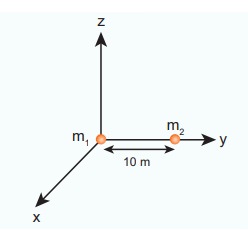
Solution
The
force of attraction is given by

From
the figure, r =10 m.
First,
we can calculate the magnitude of the force

It
is to be noted that this force is very small. This is the reason we do not feel
the gravitational force of attraction between each other. The small value of G
plays a very crucial role in deciding the strength of the force.
The
force of attraction (![]() )
experienced by the mass m2 due to m1 is in the negative
ŌĆśyŌĆÖ direction ie., r╦å =ŌłÆj╦å
. According to NewtonŌĆÖs third law, the mass m2 also exerts equal and
opposite force on m1. So the force of attraction (
)
experienced by the mass m2 due to m1 is in the negative
ŌĆśyŌĆÖ direction ie., r╦å =ŌłÆj╦å
. According to NewtonŌĆÖs third law, the mass m2 also exerts equal and
opposite force on m1. So the force of attraction (![]() ) experienced by m1
due to m2 is in the direction of positive ŌĆśyŌĆÖ axis ie., r╦å
= jˆ .
) experienced by m1
due to m2 is in the direction of positive ŌĆśyŌĆÖ axis ie., r╦å
= jˆ .
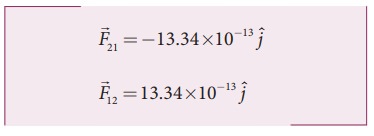
The
direction of the force is shown in the figure,
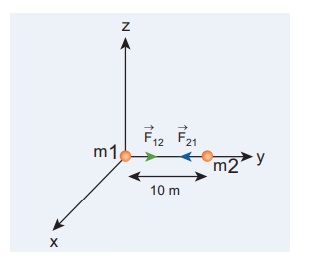
Gravitational
force of attraction between m1 and m2
![]() =
ŌłÆ
=
ŌłÆ![]() which confirms NewtonŌĆÖs third law.
which confirms NewtonŌĆÖs third law.
Important features of gravitational force:
As
the distance between two masses increases, the strength of the force tends to
decrease because of inverse dependence on r2.
Physically it implies that the planet Uranus experiences less gravitational
force from the Sun than the Earth since Uranus is at larger distance from
the Sun compared to the Earth.
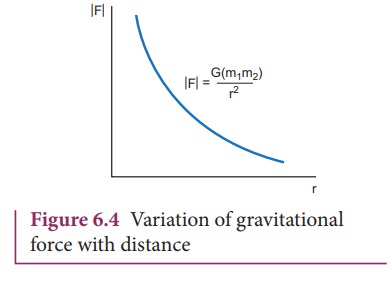
The
gravitational forces between two particles always constitute an action-reaction
pair. It implies that the gravitational force exerted by the Sun on the Earth
is always towards the Sun. The reaction-force is exerted by the Earth on the
Sun. The direction of this reaction force is towards Earth.
The
torque experienced by the Earth due to the gravitational force of the Sun is
given by
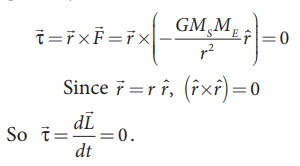
It implies that angular momentum ![]() is a constant vector. The angular
momentum of the Earth about the Sun is constant throughout the motion. It is
true for all the planets. In fact, this constancy of angular momentum leads to
the KeplerŌĆÖs second law.
is a constant vector. The angular
momentum of the Earth about the Sun is constant throughout the motion. It is
true for all the planets. In fact, this constancy of angular momentum leads to
the KeplerŌĆÖs second law.
The expression  has
one inherent assumption that both M1 and M2 are treated as point masses. When it is said that Earth orbits around the Sun
due to SunŌĆÖs gravitational force, we assumed Earth and Sun to be point masses.
This assumption is a good approximation because the distance between the two
bodies is very much larger than their diameters. For some irregular and
extended objects separated by a small distance, we cannot directly use the
equation (6.3). Instead, we have to invoke separate mathematical treatment
which will be brought forth in higher classes.
has
one inherent assumption that both M1 and M2 are treated as point masses. When it is said that Earth orbits around the Sun
due to SunŌĆÖs gravitational force, we assumed Earth and Sun to be point masses.
This assumption is a good approximation because the distance between the two
bodies is very much larger than their diameters. For some irregular and
extended objects separated by a small distance, we cannot directly use the
equation (6.3). Instead, we have to invoke separate mathematical treatment
which will be brought forth in higher classes.
However, this assumption about point masses holds even for small distance for one special case. To calculate force of attraction between a hollow sphere of mass M with uniform density and point mass m kept outside the hollow sphere, we can replace the hollow sphere of mass M as equivalent to a point mass M located at the center of the hollow sphere. The force of attraction between the hollow sphere of mass M and point mass m can be calculated by treating the hollow sphere also as another point mass.
Essentially the entire mass of the hollow
sphere appears to be concentrated at the center of the hollow sphere. It is
shown in the Figure 6.5(a).
There
is also another interesting result. Consider a hollow sphere of mass M. If we
place another object of mass ŌĆśmŌĆÖ inside this hollow sphere as in Figure 6.5(b),
the force experienced by this mass ŌĆśmŌĆÖ will be zero. This calculation will be
dealt with in higher classes.
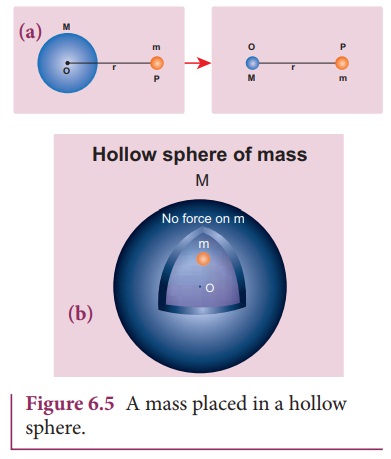
The
triumph of the law of gravitation is that it concludes that the mango that is
falling down and the Moon orbiting the Earth are due to the same gravitational
force.
NewtonŌĆÖs inverse square Law:
Newton
considered the orbits of the planets as circular. For circular orbit of radius
r, the centripetal acceleration towards the center is
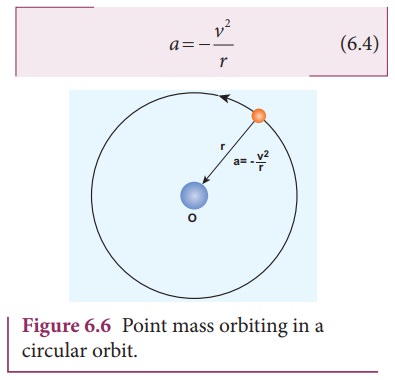
Here
v is the velocity and r, the distance of the planet from the center of the
orbit (Figure 6.6).
The
velocity in terms of known quantities r and T, is

Here
T is the time period of revolution of the planet. Substituting this value of v
in equation (6.4) we get,

Substituting
the value of ŌĆśaŌĆÖ from (6.6) in NewtonŌĆÖs second law, F = ma,
where ŌĆśmŌĆÖ is the mass of the planet.

From
KeplerŌĆÖs third law,


By
substituting equation 6.9 in the force expression, we can arrive at the law of
gravitation.

Here
negative sign implies that the force is attractive and it acts towards the
center. In equation (6.10), mass of the planet ŌĆśmŌĆÖ comes explicitly. But Newton
strongly felt that according to his third law, if Earth is attracted by the
Sun, then the Sun must also be attracted by the Earth with the same magnitude
of force. So he felt that the SunŌĆÖs mass (M) should also occur explicitly in
the expression for force (6.10). From this insight, he equated the constant 4ŽĆ2k to GM which turned out to be the law of
gravitation

Again
the negative sign in the above equation implies that the gravitational force is
attractive.
In the above discussion we assumed that the orbit of the planet to be circular which is not true as the orbit of the planet around the Sun is elliptical. But this circular orbit assumption is justifiable because planetŌĆÖs orbit is very close to being circular and there is only a very small deviation from the circular shape.
EXAMPLE 6.2
Moon
and an apple are accelerated by the same gravitational force due to Earth.
Compare the acceleration of the two.
The
gravitational force experienced by the apple due to Earth

Here
MA ŌĆō Mass of the apple, MEŌĆō Mass of the Earth and R ŌĆō
Radius of the Earth.
Equating
the above equation with NewtonŌĆÖs second law,

Simplifying
the above equation we get,

Here
aA is the acceleration of
apple that is equal to ŌĆśgŌĆÖ.
Similarly
the force experienced by Moon due to Earth is given by

Here
Rm- distance of the Moon from the Earth, Mm ŌĆō Mass of the
Moon
The
acceleration experienced by the Moon is given by

The
ratio between the appleŌĆÖs acceleration to MoonŌĆÖs acceleration is given by

From
the Hipparchrus measurement, the distance to the Moon is 60 times that of Earth
radius. Rm = 60R.

The
appleŌĆÖs acceleration is 3600 times the acceleration of the Moon.
The
same result was obtained by Newton using his gravitational formula. The appleŌĆÖs
acceleration is measured easily and it is 9.8 m sŌłÆ2 . Moon orbits
the Earth once in 27.3 days and by using the centripetal acceleration formula,
(Refer unit 3).

which
is exactly what he got through his law of gravitation.
Related Topics